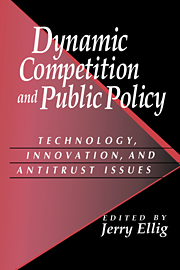Book contents
- Frontmatter
- Contents
- List of Figures and Tables
- Acknowledgments
- List of Contributors
- Introduction
- 1 A Taxonomy of Dynamic Competition Theories
- 2 Competence Explanations of Economic Profits in Strategic Management: Some Policy Implications
- 3 Innovation and Antitrust Enforcement
- 4 New Indicia for Antitrust Analysis in Markets Experiencing Rapid Innovation
- 5 Innovation and Monopoly Leveraging
- 6 Network Effects and the Microsoft Case
- 7 Technological Standards, Innovation, and Essential Facilities: Toward a Schumpeterian Post-Chicago Approach
- 8 Intellectual Property and Antitrust Limitations on Contract
- 9 Conclusion
- Index
3 - Innovation and Antitrust Enforcement
Published online by Cambridge University Press: 05 June 2012
- Frontmatter
- Contents
- List of Figures and Tables
- Acknowledgments
- List of Contributors
- Introduction
- 1 A Taxonomy of Dynamic Competition Theories
- 2 Competence Explanations of Economic Profits in Strategic Management: Some Policy Implications
- 3 Innovation and Antitrust Enforcement
- 4 New Indicia for Antitrust Analysis in Markets Experiencing Rapid Innovation
- 5 Innovation and Monopoly Leveraging
- 6 Network Effects and the Microsoft Case
- 7 Technological Standards, Innovation, and Essential Facilities: Toward a Schumpeterian Post-Chicago Approach
- 8 Intellectual Property and Antitrust Limitations on Contract
- 9 Conclusion
- Index
Summary
In evaluating markets with relatively homogeneous products and a fixed or slowly evolving technological base, the Antitrust Division of the Department of Justice (DoJ) often focuses on the price effects of potentially anticompetitive behavior. In dynamic industries, however, technological change and innovation receive particular attention. Innovation affects not only the prices that consumers pay for given products but, more important, the quality of products available in the marketplace. Moreover, the force of the innovation process can lead to dramatically higher-quality products being offered at lower prices to consumers in the future. An understanding of the particulars of competition in dynamic industries is, consequently, a vital part of a sound antitrust policy.
Some observers have questioned whether the antitrust laws are adequate to handle the complexities associated with rapidly innovating industries. The antitrust laws, of course, were passed initially to confront issues in “smokestack” industries in which rates of innovation were slow. However, the statutory standard set by Congress is a flexible standard that can be and has been applied to dynamic industries. The specifics of how that standard is to be applied remain open for serious debate. We are of the view that in dynamic innovative industries antitrust enforcement should be forward-looking as much as possible and that accelerated antitrust enforcement must be given serious consideration before the path of innovative activity is set in stone. We believe that this view has been borne out by antitrust activity at the Antitrust Division in recent years.
- Type
- Chapter
- Information
- Dynamic Competition and Public PolicyTechnology, Innovation, and Antitrust Issues, pp. 65 - 94Publisher: Cambridge University PressPrint publication year: 2001
- 9
- Cited by



